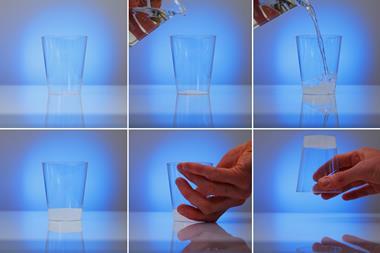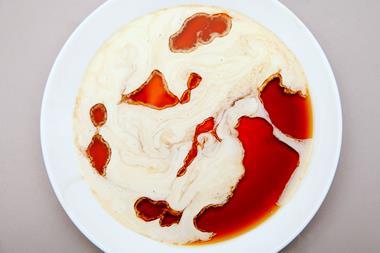The chemiluminescence of luminol is a popular demonstration. Students really enjoy experiencing the eerie 'cold light' released from the reaction. This is often shown by pouring one liquid into another, either directly, or via a coiled length of transparent tubing as explained in a previous Exhibition Chemistry.1 This reaction can be displayed even more dramatically by using a fountain apparatus to mix the liquids. The basic environment of the ammonia fountain lends itself well to the luminol reaction, which works best at high pH.
Kit
- 0.5-2 dm3 round bottomed flask
- 2 conical flasks (at least 0.5 dm3)
- 20 cm3 plastic syringe
- Delivery tubes (see diagram2)
- Drying tube (optional)
- 0.4 g luminol (3-aminophthalhydrazide) (irritant)
- 100 cm3 NaClO(aq) use either thin household bleach (around 5% NaClO solution, not H2O2) (irritant), or 50 cm3 commercially available NaClO solution (corrosive)
- 4 g NaOH pellets (corrosive)
- 10 cm3 concentrated (880) NH3(l) (corrosive, ammonia gas is toxic)
- 10 g KOH pellets (corrosive)
- Eye protection
Preparation
There are a number of ways to prepare luminol solutions. The idea for this demonstration came from the Salters Chemistry Club resources2 but I've found it works better with the recipe suggested in Classic Chemistry Demonstrations (CCD).3 It will work using the recipe suggested previously in Education in Chemistry1 and the glow lasts longer, but that recipe will take longer to prepare and this one works well.
For the luminol solutions
In one 1 dm3 flask, dilute 100 cm3 of household bleach (or 50 cm3 of commercial NaClO solution) with 900 (or 950) cm3 of water.
In another flask dissolve 4 g of NaOH and 0.4 g of luminol in 1 dm3 water. This mixture will be slow to dissolve so prepare at least 1 hour ahead of time. These solutions are fairly stable and while some sources recommend using the solutions within 12 hours, I've found them to still work after a few months in the store cupboard.
Preparing the apparatus
The glassware needs to be bone dry for this demonstration to work: if necessary rinse it with propanone and allow this to evaporate. The round bottomed flask can be filled with gaseous ammonia by gently heating 10 cm3 of ammonia in a boiling tube with a small Bunsen flame or a hairdryer. The resulting gas can be passed over 10 g of potassium hydroxide in a drying tube (optional) and collected by downward displacement of the denser air (see the diagram on p216 of CCD3) before connecting to the fountain apparatus (see the Salters' diagram2). To ensure the flask is full of ammonia you can hold damp indicator paper at the mouth of the flask while collecting the gas.
In front of the audience
With the apparatus set up, you can initiate the fountain by quickly injecting the 20 cm3 of water from the syringe. If you do not successfully start the fountain, draw back some water into the syringe and squirt it back in, ensuring the spray reaches up into the main bulb of the flask. As the ammonia dissolves in the water, the pressure drops, drawing up fluid from the two flasks to initiate the chemiluminescent reaction. Glowing blue liquid sprays up and around the sides of the flask.
Teaching goal
This demonstration works particularly well with 14-16 year old students who may be studying the solubility of gases, the properties and reactions of ammonia and introductory thermodynamics around the same time. You may wish to show the demonstration by simply mixing the two liquids to start with in conical flasks. The temperature of the liquids at the start and at the end can be measured to show that no heat energy is absorbed or released, only light energy
Filling the flask with ammonia in front of the students will allow you to discuss more of its properties: highlight the use of downward displacement because of its density and the ease with which it vaporises, as well as the production of an alkaline solution on the moist indicator paper.
Safety
Wear eye protection. Goggles should be worn when preparing the solution.The flask must be filled with ammonia while in a fume cupboard.When performing the demonstration, either use a fume cupboard or two safety screens (one to protect the audience and one for the demonstrator).
References
1. http://rsc.li/TWU5Mt
2. http://bit.ly/XinTzE (PDF)
3. T Lister, Classic chemistry demonstrations, p215. Cambridge, UK: Royal Society of Chemistry, 1996

















1 Reader's comment